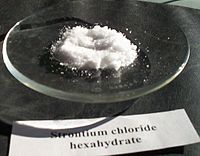Strontium chloride

| |
| Names | |
|---|---|
| IUPAC name
Strontium chloride
| |
| Other names
Strontium(II) chloride
| |
| Identifiers | |
| |
3D model (JSmol)
|
|
| ChemSpider | |
| ECHA InfoCard | 100.030.870 |
| UNII | |
CompTox Dashboard (EPA)
|
|
| |
| |
| Properties | |
| SrCl2 | |
| Molar mass | 158.53 g/mol (anhydrous) 266.62 g/mol (hexahydrate) |
| Appearance | White crystalline solid |
| Density | 3.052 g/cm3 (anhydrous, monoclinic form) 2.672 g/cm3 (dihydrate) 1.930 g/cm3 (hexahydrate) |
| Melting point | 874 °C (anhydrous) 61 °C (hexahydrate) |
| Boiling point | 1250 °C (anhydrous) |
| anhydrous: 53.8 g/100 mL (20 °C) hexahydrate: 106 g/100 mL (0 °C) 206 g/100 mL (40 °C) | |
| Solubility | ethanol: very slightly soluble acetone: very slightly soluble ammonia: insoluble |
Refractive index (nD)
|
1.650 (anhydrous) 1.594 (dihydrate) 1.536 (hexahydrate) [1] |
| Structure | |
| Deformed rutile structure | |
| octahedral (six-coordinate) | |
| Hazards | |
| Occupational safety and health (OHS/OSH): | |
Main hazards
|
Irritant |
| Flash point | Non-flammable |
| Related compounds | |
Other anions
|
Strontium fluoride Strontium bromide Strontium iodide |
Other cations
|
Beryllium chloride Magnesium chloride Calcium chloride Barium chloride Radium chloride |
Except where otherwise noted, data are given for materials in their standard state (at 25 °C [77 °F], 100 kPa).
| |
Strontium chloride (SrCl2) is a salt of strontium and chloride. It is a typical salt, forming neutral aqueous solutions. Like all compounds of Sr, this salt emits a bright red colour in a flame and in fact is used as a source of redness in fireworks. Its chemical properties are intermediate between those for barium chloride, which is more toxic, and calcium chloride.
Preparation
Strontium chloride can be prepared by treating strontium hydroxide or strontium carbonate with hydrochloric acid:
- Sr(OH)2 + 2 HCl → SrCl2 + 2 H2O
Crystallization from cold aqueous solution gives the hexahydrate, SrCl2·6H2O. Dehydration of this salt occurs in stages, commencing above 61 °C. Full dehydration occurs at 320 °C.[2]
Structure
The solid adopts a deformed rutile structure.[3] In the vapour phase the SrCl2 molecule is non-linear with a Cl-Sr-Cl angle of approximately 130°. [3] This is an exception to VSEPR theory which would predict a linear structure. Ab initio calculations have been cited to propose that contributions from d orbitals in the shell below the valence shell are responsible.[4] Another proposal is that polarisation of the electron core of the strontium atom causes a distortion of the core electron density that interacts with the Sr-Cl bonds.[5]
Uses
Strontium chloride is the precursor to other compounds of strontium, such as yellow strontium chromate, which is used as a corrosion inhibitor for aluminium. The precipitation proceeds analogously to the related, isostructural sulfate: [2]
Strontium chloride is often used as a red colouring agent in pyrotechnics. It imparts a much more intense red colour to the flames than most other alternatives. It is employed in small quantities in glass-making and metallurgy. The radioactive isotope strontium-89, used for the treatment of bone cancer, is usually administered in the form of strontium chloride. Sea water aquaria require small amounts of strontium chloride, which is consumed in the production of the exoskeletons of certain plankton.
Dental care
SrCl2 is useful in reducing tooth sensitivity by forming a barrier over microscopic tubules in the dentin containing nerve endings that have become exposed by gum recession. Known in the US as Elecol and Sensodyne, these products are called "strontium chloride toothpastes", although most now use potassium nitrate instead which works as a nerve calming agent rather than a barrier.[1]
References
- ^ Pradyot Patnaik. Handbook of Inorganic Chemicals. McGraw-Hill, 2002, ISBN 0070494398
- ^ a b J. Paul MacMillan, Jai Won Park, Rolf Gerstenberg, Heinz Wagner, Karl Köhler, Peter Wallbrecht "Strontium and Strontium Compounds" in Ullmann's Encyclopedia of Industrial Chemistry, 2005, Wiley-VCH: Weinheim. DOI 10.1002/14356007.a25 321
- ^ a b Greenwood, Norman N.; Earnshaw, Alan (1997). Chemistry of the Elements (2nd ed.). Butterworth-Heinemann. ISBN 978-0-08-037941-8.
- ^ Ab initio model potential study of the equilibrium geometry of alkaline earth dihalides: MX2 (M=Mg, Ca, Sr, Ba; X=F, Cl, Br, I)Seijo L.,Barandiarán Z J. Chem. Phys. 94, 3762 (1991) Error: Bad DOI specified!
- ^ Ion model and equilibrium configuration of the gaseous alkaline-earth dihalides Guido M. and Gigli G. J. Chem. Phys. 65, 1397 (1976); doi:10.1063/1.433247
